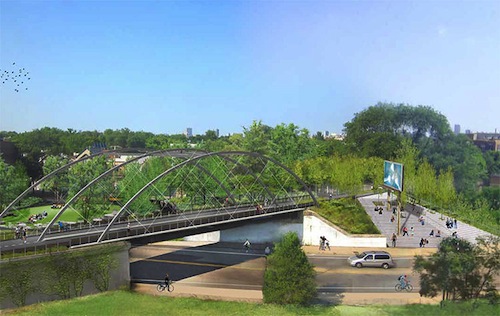Plans are moving forward to convert an unused, century-old Chicago rail artery to a 2.7 mile, 13-acre recreational facility and transit corridor. Unlike New York's High Line, the Bloomingdale Trail and Park will welcome bicycles as well as pedestrians, linking trendy and transitional neighborhoods on the city's Near North Side (Bucktown, Wicker Park, Logan Square, Humboldt Park) with public transportation to other parts of the city and suburbs.
Six "anchor parks" owned by the city will serve as access points to the trail, providing additional space for arts performances and recreation. Public funding will be used for the $91 million job, including $39 million in federal Congestion Mitigation and Air Quality funds. Michael Van Valkenburgh Associates led the Phase I planning team, with groundbreaking possible this year and completion as early as the end of 2014. Collins Engineers is helming the Phase II design, with Frances Whitehead named as lead artist. Participating agencies include the Chicago Department of Transportation, Chicago Park District, Department of Housing and Economic Development, Department of Cultural Affairs and Special Events, Trust for Public Land, and local community groups.
If the project succeeds, long-range plans would extend the trail eastward, ultimately crossing the Chicago River and Kennedy Expressway (I-90).
(http://www.archdaily.com/354677/chicago-on-track-to-break-ground-on-elevated-parkway/)
Related Stories
| Jan 19, 2011
Architecture Billings Index jumped more than 2 points in December
On the heels of its highest mark since 2007, the Architecture Billings Index jumped more than two points in December. The American Institute of Architects reported the December ABI score was 54.2, up from a reading of 52.0 the previous month.
| Jan 19, 2011
Large-Scale Concrete Reconstruction Solid Thinking
Driven by both current economic conditions and sustainable building trends, Building Teams are looking more and more to retrofits and reconstruction as the most viable alternative to new construction. In that context, large-scale concrete restoration projects are playing an important role within this growing specialty.
| Jan 10, 2011
Architect Jean Nouvel designs an island near Paris
Abandoned by carmaker Renault almost 20 years ago, Seguin Island in Boulogne-Billancourt, France, is being renewed by architect Jean Nouvel. Plans for the 300,000-square-meter project includes a mix of culture, commerce, urban parks, and gardens, which officials hope will attract both Parisians and tourists.
| Jan 10, 2011
Michael J. Alter, president of The Alter Group: ‘There’s a significant pent-up demand for projects’
Michael J. Alter, president of The Alter Group, a national corporate real estate development firm headquartered in Skokie, Ill., on the growth of urban centers, project financing, and what clients are saying about sustainability.
| Jan 7, 2011
BIM on Target
By using BIM for the design of its new San Clemente, Calif., store, big-box retailer Target has been able to model the entire structural steel package, including joists, in 3D, chopping the timeline for shop drawings from as much as 10 weeks down to an ‘unheard of’ three-and-a-half weeks.
| Jan 7, 2011
How Building Teams Choose Roofing Systems
A roofing survey emailed to a representative sample of BD+C’s subscriber list revealed such key findings as: Respondents named metal (56%) and EPDM (50%) as the roofing systems they (or their firms) employed most in projects. Also, new construction and retrofits were fairly evenly split among respondents’ roofing-related projects over the last couple of years.
| Jan 7, 2011
Total construction to rise 5.1% in 2011
Total U.S. construction spending will increase 5.1% in 2011. The gain from the end of 2010 to the end of 2011 will be 10%. The biggest annual gain in 2011 will be 10% for new residential construction, far above the 2-3% gains in all other construction sectors.
| Jan 7, 2011
Mixed-Use on Steroids
Mixed-use development has been one of the few bright spots in real estate in the last few years. Successful mixed-use projects are almost always located in dense urban or suburban areas, usually close to public transportation. It’s a sign of the times that the residential component tends to be rental rather than for-sale.














